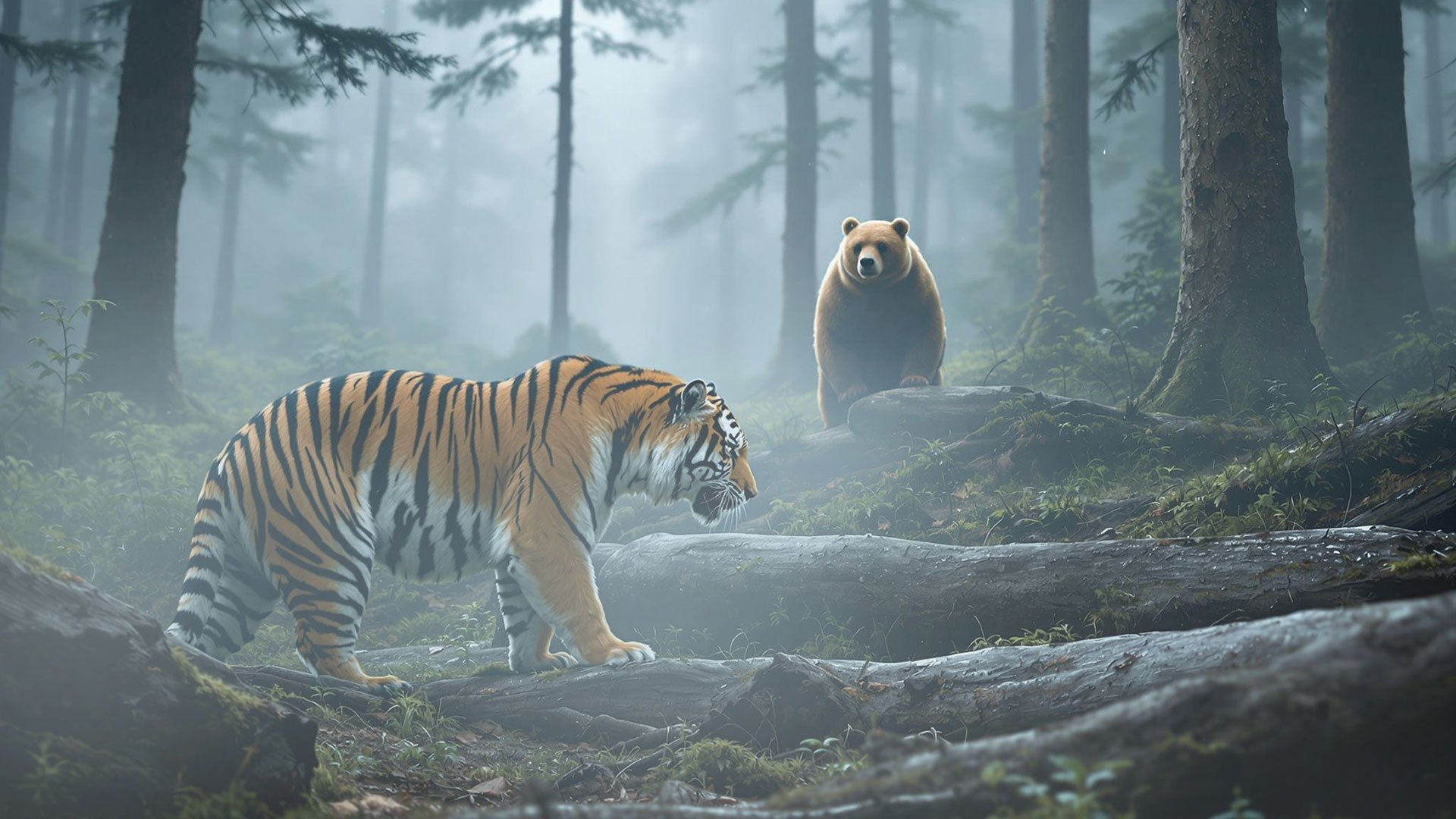The Apex Paradox: When Siberian Tigers Hunt Brown Bears
AI Siberian Tiger Stalking Bear
Deep in the forests of northeastern China, a hidden battle has been unfolding—one that scientists only recently uncovered. For years, brown bears in these remote regions feared little aside from humans. But now, camera traps and ecological studies have revealed a stunning reality: Siberian tigers, the largest big cats on Earth, are actively hunting and eating brown bears.
A Shocking Discovery
When researchers analyzed the scat of wild Siberian tigers, they found an unexpected presence—brown bear remains. Further analysis revealed that up to 10% of a Siberian tiger’s diet consists of bears. This was no isolated incident. Remote cameras captured chilling footage of these massive cats stalking, ambushing, and ultimately taking down bears in the dense forests of China.
At first, the discovery seemed almost unbelievable. Brown bears are formidable predators in their own right, strong and resourceful, often outcompeting other carnivores for food. But the Siberian tiger—a stealthy, 600-pound, perfectly engineered predator—has found a way to turn the tables.
How Does a Tiger Take Down a Bear?
Siberian tigers are master ambush predators. Unlike bears, who rely on brute strength and endurance, tigers operate in the shadows, using their striped coats as camouflage among the trees. When they strike, they do so with precision and deadly force, aiming for the back of the neck to sever the spine or suffocate their prey with a crushing bite to the throat.
Some brown bears may put up a fight, but even they struggle against a tiger’s overwhelming speed, agility, and sheer muscle. The tigers may not always target the largest bears, but they have been recorded hunting both adult and juvenile brown bears, proving their dominance over a species many assumed to be nearly untouchable in the wild.
What This Means for the Ecosystem
This discovery reshapes our understanding of predator hierarchies. We tend to see tigers and bears as rivals, but this new evidence suggests a more complex interaction—one where tigers are not just competitors, but apex predators enforcing a balance in the ecosystem.
While it may be shocking to some, predation plays a critical role in maintaining healthy ecosystems. Without tigers controlling populations of prey—and even other carnivores—certain species could overpopulate, leading to habitat degradation and food shortages.
But here’s the real crisis: Siberian tigers are critically endangered. With only 400-500 remaining in the wild, their disappearance would leave an immense gap in this ecosystem. Without these apex predators, prey populations could explode, throwing nature into chaos.
Why Protecting Tigers Matters More Than Ever
Tigers are not just powerful and majestic; they are keystone species—animals that hold entire ecosystems together. If they vanish, everything changes. The forests they roam, the rivers they hunt near, and even the carbon stored in these landscapes depend on the delicate balance tigers maintain.
However, these magnificent cats face relentless threats. Poaching, habitat destruction, and human-wildlife conflict continue to shrink their numbers. Conservation efforts have helped, but the battle to save Siberian tigers is far from over.
What Can You Do to Help?
The fight to protect big cats isn’t just about saving one species—it’s about ensuring the survival of entire ecosystems. Here’s how you can make a difference:
🔹 Support Conservation Organizations – Groups like Big Cat Rescue fund essential tiger conservation projects, from habitat protection to anti-poaching initiatives.
🔹 Advocate for Stronger Wildlife Protections – The Big Cat Public Safety Act helped end private big cat ownership and cub petting in the U.S., but international laws need to follow suit to protect tigers in the wild.
🔹 Share Awareness – Many people don’t realize how endangered these cats are. By sharing stories like this one, you help spread the urgency of tiger conservation.
🔹 Make Sustainable Choices – The destruction of forests for palm oil, logging, and development threatens tiger habitats. Choosing products that support sustainable practices helps preserve their home.
A Future Where Tigers Still Roam
The fact that Siberian tigers can hunt brown bears speaks to their power and resilience. But their greatest battle isn’t against bears—it’s against extinction.
These majestic creatures have been rulers of the forests for thousands of years. If we act now, they can continue to prowl the wilderness, keeping ecosystems thriving and inspiring future generations.
The choice is ours: will we let the last Siberian tigers fade into history, or will we fight to protect their reign?
The time to act is now. Join the movement. Protect the wild. Save the tigers.
